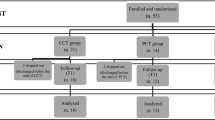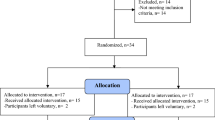Abstract
Purpose
Although patients scheduled to undergo lumbar disc surgery often ask when they are allowed to drive a motor vehicle again, there are no published recommendations on this subject.
Methods
We conducted a prospective study in 46 consecutive patients (mean age 48.9 years) to determine driving reaction time (DRT) before and after surgery in patients with lumbar disc herniation. Of the patients 23 had left-side radiculopathy and 23 right-side radiculopathy. Driving reaction time as well as back and leg pain were evaluated preoperatively, on the day of discharge from hospital and at the 5-week follow-up examination (FU). 31 healthy subjects were tested as controls.
Results
Significant improvement in DRT was seen for both patient samples (p < 0.05). For patients with a right-side radiculopathy preoperative DRT was 664 ms (median, IQR: 241), which was reduced to 605 ms (median, IQR: 189) immediately postoperatively and to 593 ms (median, IQR: 115) at FU. For patients with a left-side radiculopathy DRT was 675 ms (median, IQR: 247) preoperatively, 638 ms (median, IQR: 242) postoperatively and 619 ms (median, IQR: 162) at FU. Pain was moderately correlated to DRT. Control subjects had a driving reaction time of 487 (median, IQR: 116), which differed significantly from patients at all three testing times (p < 0.001).
Conclusion
Our data indicate a positive effect of the surgery on driving ability. Therefore, we would suggest that for both patient samples it is safe to continue driving after hospital discharge. However, patients have to be informed about increased DRT caused by radiculopathy already before surgery.



Similar content being viewed by others
References
Nellensteijn J, Ostelo R, Bartels R, Peul W, van Royen B, van Tulder M (2010) Transforaminal endoscopic surgery for symptomatic lumbar disc herniations: a systematic review of the literature. Eur Spine J Off Publ Eur Spine Soc Eur Spinal Deformity Soc Eur Sect Cerv Spine Res Soc 19(2):181–204. doi:10.1007/s00586-009-1155-x
Atlas SJ, Chang Y, Kammann E, Keller RB, Deyo RA, Singer DE (2000) Long-term disability and return to work among patients who have a herniated lumbar disc: the effect of disability compensation. J Bone Joint Surg Am 82(1):4–15
Deyo RA, Weinstein JN (2001) Low back pain. N Engl J Med 344(5):363–370. doi:10.1056/NEJM200102013440508
Atlas SJ, Keller RB, Wu YA, Deyo RA, Singer DE (2005) Long-term outcomes of surgical and nonsurgical management of sciatica secondary to a lumbar disc herniation: 10 year results from the maine lumbar spine study. Spine (Phila Pa 1976) 30 (8):927–935
Smith JS, Fu KM, Polly DW Jr, Sansur CA, Berven SH, Broadstone PA, Choma TJ, Goytan MJ, Noordeen HH, Knapp DR Jr, Hart RA, Donaldson WF, 3rd, Perra JH, Boachie-Adjei O, Shaffrey CI (2010) Complication rates of three common spine procedures and rates of thromboembolism following spine surgery based on 108,419 procedures: a report from the Scoliosis Research Society Morbidity and Mortality Committee. Spine (Phila Pa 1976) 35 (24):2140–2149. doi:10.1097/BRS.0b013e3181cbc8e7
Silverplats K, Lind B, Zoega B, Halldin K, Rutberg L, Gellerstedt M, Brisby H (2010) Clinical factors of importance for outcome after lumbar disc herniation surgery: long-term follow-up. Eur Spine J Off Publ Eur Spine Soc Eur Spinal Deformity Soc Eur Sect Cerv Spine Res Soc 19(9):1459–1467. doi:10.1007/s00586-010-1433-7
Dedering A (2011) Lumbar muscle fatigue and subjective health measurements in patients with lumbar disc herniation 2 years after surgery. Eur Spine J Off Publ Eur Spine Soc Eur Spinal Deformity Soc Eur Sect Cerv Spine Res Soc. doi:10.1007/s00586-011-2109-7
Al-khayer A, Schueler A, Kruszewski G, Armstrong G, Grevitt MP (2008) Driver reaction time before and after treatment for lumbar radiculopathy. Spine (Phila Pa 1976) 33 (15):1696–1700. doi:10.1097/BRS.0b013e31817b5bb7
Pierson JL, Earles DR, Wood K (2003) Brake response time after total knee arthroplasty: when is it safe for patients to drive? J Arthroplasty 18(7):840–843
MacDonald W, Owen JW (1988) The effect of total hip replacement on driving reactions. J Bone Joint Surg Br 70(2):202–205
Ganz SB, Levin AZ, Peterson MG, Ranawat CS (2003) Improvement in driving reaction time after total hip arthroplasty. Clin Orthop Relat Res 413:192–200. doi:10.1097/01.blo.0000072468.32680.ff
Spalding TJ, Kiss J, Kyberd P, Turner-Smith A, Simpson AH (1994) Driver reaction times after total knee replacement. J Bone Joint Surg Br 76(5):754–756
Liebensteiner MC, Kern M, Haid C, Kobel C, Niederseer D, Krismer M (2010) Brake response time before and after total knee arthroplasty: a prospective cohort study. BMC Musculoskelet Disord 11:267. doi:10.1186/1471-2474-11-267
Gotlin RS, Sherman AL, Sierra N, Kelly MA, Pappas Z, Scott WN (2000) Measurement of brake response time after right anterior cruciate ligament reconstruction. Arch Phys Med Rehabil 81(2):201–204
Gotlin RS, Sherman AL, Sierra N, Kelly M, Scott WN (2000) Measurement of brake response time after right anterior cruciate ligament reconstruction. Arthroscopy 16(2):151–155
Hau R, Csongvay S, Bartlett J (2000) Driving reaction time after right knee arthroscopy. Knee Surg Sports Traumatol Arthrosc 8(2):89–92
Liebensteiner MC, Birkfellner F, Thaler M, Haid C, Bach C, Krismer M (2010) Driving reaction time before and after primary fusion of the lumbar spine. Spine (Phila Pa 1976) 35 (3):330–335. doi:10.1097/BRS.0b013e3181b8e11a
Burckhardt M (1985) Reaktionszeiten bei Notbremsvorgangen. Rheinland, Cologne
Department of Transport COI (1978) The Highway code. Her majesty’s stationery office, London
Royal Automobile Club of Victoria (1996) Average reaction, breaking and stopping distances in metres at different speed with reaction time of 0.75 seconds. Royal Automobile Club of Victoria, Melbourne
Scott PA, Candler PD, Li JC (1996) Stature and seat position as factors affecting fractionated response time in motor vehicle drivers. Appl Ergon 27(6):411–416
Marques CJ, Barreiros J, Cabri J, Carita AI, Friesecke C, Loehr JF (2008) Does the brake response time of the right leg change after left total knee arthroplasty? A prospective study. Knee 15(4):295–298. doi:10.1016/j.knee.2008.02.008
Stokes M, Young A (1984) The contribution of reflex inhibition to arthrogenous muscle weakness. Clin Sci (Lond) 67(1):7–14
Sabatowski R (2008) Driving ability under opioids: current assessment of published studies. Dtsch Med Wochenschr 133(Suppl 2):S25–S28. doi:10.1055/s-2008-1081067
Byas-Smith MG, Chapman SL, Reed B, Cotsonis G (2005) The effect of opioids on driving and psychomotor performance in patients with chronic pain. Clin J Pain 21(4):345–352
Nunez VA, Giddins GE (2004) ‘Doctor, when can I drive?’: an update on the medico-legal aspects of driving following an injury or operation. Injury 35(9):888–890. doi:10.1016/j.injury.2003.11.009
Conflict of interest
None of the authors has received support for this work from any of the following organizations: National Institutes of Health (NIH); Welcome Trust; Howard Hughes Medical Institute (HHMI); other foundation(s) requiring open access.
Author information
Authors and Affiliations
Corresponding author
Additional information
M. Thaler and R. Lechner have contributed equally to this work.
Rights and permissions
About this article
Cite this article
Thaler, M., Lechner, R., Foedinger, B. et al. Driving reaction time before and after surgery for lumbar disc herniation in patients with radiculopathy. Eur Spine J 21, 2259–2264 (2012). https://doi.org/10.1007/s00586-012-2378-9
Received:
Revised:
Accepted:
Published:
Issue Date:
DOI: https://doi.org/10.1007/s00586-012-2378-9




